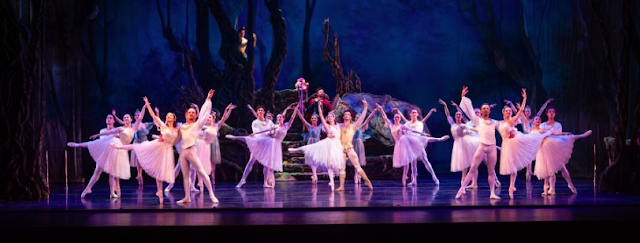With Bruce Wells choreography, Midsummer is pure magic
Fairy kings and queens, mischievous woodland spirits, young lovers, and merry buffoons — nearly all of Shakespeare’s characters are present in the wondrous production that is A Midsummer Night’s Dream at the Milwaukee Ballet. The company, armed with stunning Bruce Wells choreography, casts a spell of dance that’s not to be missed, whether you’re a lover of classical ballet, fairytale magic, or the Bard’s most bewitching comedy.
A Midsummer Night’s Dream is the story of four lovers. Hermia and Lysander are in love, Demetrius also loves Hermia, and Helena loves Demetrius. The four escape into the forest realm to pursue those loves. Meanwhile, the fairy king and queen, Oberon and Titania, are quarreling, and the fairy Puck is about to cause accidental trouble for the four mortals by way of an enchanted flower. There’s also a troupe of foolish theatrical players who find themselves in the forest — one of whom Puck gifts the head of a donkey as an absurd prank.

It’s a lot to keep track of, but the Milwaukee Ballet does a wonderful job of telling the Bard’s story through not only the choreography, but also costuming. Most notably, the four lovers, who might otherwise be easy to confuse in a nonverbal production, are outfitted to match their intended partner.
Through the choreography, it’s clear who the silly ones are in this Shakespeare comedy. The heartsick Helena (Alana Griffith) literally throws herself at the unwilling Demetrius (Patrick Howell) to delighted laughs. This duo nails the humor. Also funny are the four foolish players, whose bumbling moves are purposefully clumsy, though no less athletic. Even Hermia (Marize Fumero) and Lysander (Davit Hovhannisyan), whose parts lean less humorous than the others, take their turn at inspiring laughter.
The mystical beings also echo scenes in Shakespeare’s script. For one, the ballet ends with Puck (the sensational Bary Molina) delivering a sort of dancer’s monologue, just as the Bard’s Midsummer ends with the solo fairy bidding the audience good-night. When Titania (Annia Hidalgo) and Oberon (Randy Crespo) squabble, they do so in a sort of classical dance battle, she with her tribe of fairy maidens, he with his legion of fairy fellows. The final wedding scene, set to Mendelssohn’s famous tune, brings parties moral and mystic together for a truly ravishing bit of large-scale choreography.

Titania’s lullaby is also given special treatment, creating a moment on stage that is positively sublime. Imagine: The graceful whirl of dancing fairies, soaring Florentine Opera voices, a sweet chorale from the Milwaukee Children's Choir, and stirring melodies performed live by the Milwaukee Ballet Orchestra. It all comes together for a supremely special moment of artistry and wonder — wonder at how these talented groups came together to create such magic, and wonder at one’s own privilege to experience it.
Equally dazzling are costume and scenic design by Edward Baker and Lewis Folden, respectively. The fairies win Best Dressed, with company dancers aglimmer in shades silver and gold and dozens of students from the Milwaukee Ballet School awash in a rainbow of hues. Titania and Oberon especially impress in ethereal capes carried by six-or-so attendants.
The set boasts a classic painterly quality dotted with magnificent trees and tangled roots. Changes to the static scene are largely simple; large boulders roll on and off the stage to add some dimension. At times, Ballet School students sit here and there, bringing the backdrop to life. The most elaborate set element is a sort of cocoon that unfurls for the slumbering Titania. These moments are made memorable by warm, glowy lighting by David Grill.
Still, some the most inspirational lighting is also some of the simplest. At the very end of the ballet, Titania and Oberon bestow glowing orbs to each of the child fairies. The stage lights dim to darkness as the loveable Puck playfully leaps and spins, surrounded by young dancers brandishing their brilliant orbs to-and-fro, sprightly fireflies all. This is Puck’s final monologue:
“If we shadows have offended,
Think but this, and all is mended,
That you have but slumber'd here
While these visions did appear.”
Luckily for Milwaukee, this dreamy ballet is real as can be.